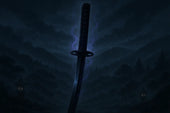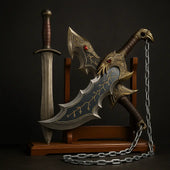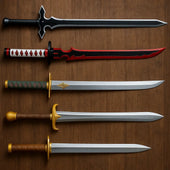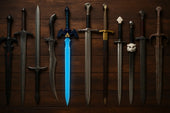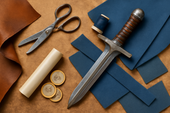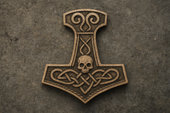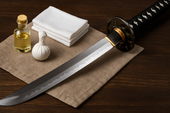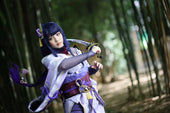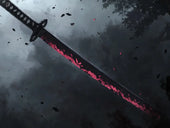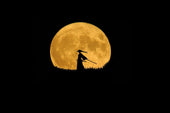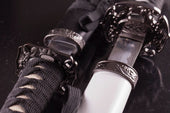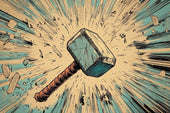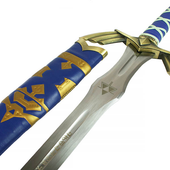The katana is one of the most iconic swords in history, known for its curved blade, razor-sharp edge, and deep connection to samurai culture. Revered not only as a weapon but as a symbol of honour, craftsmanship, and tradition, the katana has a legacy that spans centuries.
From its origins in early Japan to its influence in modern martial arts and pop culture, the katana remains a significant part of Japanese heritage. This blog will explore its history, development, craftsmanship, and how it continues to captivate enthusiasts worldwide.
The Origins of the Katana
The history of the katana dates back to Japan’s early sword-making traditions, which were influenced by Chinese and Korean weapons. The first Japanese swords were straight-edged blades called chokutō, similar to those found in China. However, as combat techniques evolved, so did the need for faster, more efficient weapons.
During the Heian period (794–1185), Japanese swordsmiths began experimenting with curved designs. This shift was due to mounted warfare, where warriors needed a weapon that could deliver quick and powerful slashes. The result was the tachi, a predecessor to the katana, which was longer and more curved. Over time, the design was refined, leading to the birth of the katana during the Kamakura period (1185–1333).
The Development of the Katana in Feudal Japan
As Japan transitioned into the Kamakura (1185–1333) and Muromachi (1336–1573) periods, the katana became the primary weapon of the samurai, surpassing its predecessor, the tachi. This evolution was largely driven by changes in battlefield tactics and the growing emphasis on close-quarters combat.
Why the Katana Replaced the Tachi
The tachi, a longer and more curved sword, was designed primarily for mounted samurai, making it well-suited for slashing attacks from horseback. However, as military conflicts became more frequent and dynamic, samurai often fought on foot, requiring a more versatile weapon that allowed for quick engagement and adaptability.
The katana's defining characteristic was its method of wear:
-
The tachi was suspended from the waist with the edge facing downward, requiring a full draw before attacking.
-
The katana was worn edge-up, tucked into the obi (sash), enabling the samurai to unsheathe and strike in one fluid motion (a technique known as iaijutsu).
This change drastically improved reaction time, allowing warriors to counter an opponent instantly. In the heat of battle, where split-second decisions meant life or death, the katana provided a critical advantage.
Combat Efficiency and the Two-Sword Style
During this era, the katana was often wielded alongside a wakizashi (a shorter sword), forming the daishō (meaning "big-little"), a paired weapon set worn exclusively by the samurai class. This combination allowed for greater flexibility in combat, with the katana used for powerful slashes and the wakizashi for close-range or indoor fighting.
The rise of legendary sword masters, such as Miyamoto Musashi, further reinforced the katana’s dominance. Musashi famously developed the Niten Ichi-ryū (Two Heavens as One) technique, a style of wielding both swords simultaneously, maximising offensive and defensive capabilities.
A Weapon of Status and Tradition
Beyond its practicality in battle, the katana was more than just a weapon—it became a symbol of honour and prestige. Samurai believed their sword embodied their soul, treating it with reverence and care. Strict rituals were followed when handling or displaying the katana, reinforcing its spiritual significance.
By the end of the Muromachi period, the katana was firmly established as the defining weapon of the samurai, shaping Japanese martial arts, traditions, and culture for centuries to come.
Key Developments in Katana Sword-Making:
-
Differential Hardening – Swordsmiths introduced a technique called yaki-ire, where clay was applied to the blade before heating and quenching. This created a hard edge for sharpness and a softer spine for flexibility, resulting in the distinctive hamon pattern.
-
Folding Steel Technique – The process of repeatedly folding and hammering the steel removed impurities and enhanced the blade’s strength and durability.
-
Introduction of Renowned Swordsmiths – Legendary craftsmen like Masamune and Muramasa created katanas known for their unparalleled quality and beauty.
The katana was more than just a weapon—it became a status symbol, reflecting the honour, discipline, and skill of the samurai. Many samurai considered their katana their soul, treating it with great reverence.
The Craftsmanship and Symbolism of the Katana
The process of making a traditional katana is a meticulous art, requiring months or even years to complete. Skilled swordsmiths followed a rigorous process to ensure each blade was strong, balanced, and exceptionally sharp.
The Katana-Making Process:
-
Selection of Tamahagane Steel – The finest Japanese Tamahagane steel was chosen for its purity and strength.
-
Folding and Forging – The steel was heated, folded, and hammered multiple times to remove impurities and create a layered grain structure.
-
Clay Application & Quenching – A special clay mixture was applied before heating, allowing for differential hardening and the creation of the hamon (temper line).
-
Polishing & Sharpening – Expert polishers refined the blade over weeks, using progressively finer stones to achieve a mirror-like finish and razor-sharp edge.
-
Mounting the Katana – The blade was fitted with a tsuka (hilt), tsuba (handguard), and saya (scabbard), often decorated with intricate designs.
Symbolism of the Katana
Beyond its function, the katana held deep spiritual and cultural significance:
-
Bushidō (Way of the Warrior) – The katana symbolised the discipline, courage, and loyalty of the samurai.
-
Honour and Ancestry – Many katanas were passed down through generations, carrying a family’s legacy and prestige.
-
Artistry and Spirituality – Master swordsmiths treated katana-making as a sacred art, believing that their blades embodied the spirit of the samurai.
The Decline of the Katana in Warfare
With the arrival of firearms in Japan during the 16th century, the role of the katana in battlefield warfare began to decline. However, it remained an essential sidearm for samurai, and its symbolic importance persisted.
The Meiji Restoration (1868) brought about drastic changes. The Haitōrei Edict (1876) banned the public carrying of swords, marking the end of the samurai era. Many swordsmiths shifted to producing decorative or ceremonial swords, preserving traditional techniques despite a reduced demand.
The Katana in Modern Times
Despite its decline in warfare, the katana remains one of the most revered swords in history. Today, it continues to hold cultural, artistic, and functional value.
1. Martial Arts and Training
The katana is still used in traditional Japanese martial arts, including:
-
Kendo – A modern sport based on samurai sword-fighting techniques.
-
Iaido – The art of drawing, cutting, and sheathing the katana in a fluid motion.
-
Kenjutsu – The classical combat training of the samurai.
2. The Katana in Pop Culture
The katana has become a symbol of honour, power, and mystique, appearing in numerous films, anime, and video games. Some of the most famous pop culture references include:
-
Kill Bill – Showcasing highly stylised katana combat.
-
The Last Samurai – A historical representation of the samurai spirit.
-
Anime & Manga – Featured in series like Samurai Champloo, Bleach, and Rurouni Kenshin.
3. Collecting and Sword Enthusiasts
The appreciation for katanas extends beyond Japan. Collectors worldwide seek authentic hand-forged katanas, valuing their historical craftsmanship and artistic detail. Many modern swordsmiths continue to produce high-quality katanas, ensuring that the tradition of Japanese sword-making lives on.
Why the Katana’s Legacy Still Endures
The katana is more than just a sword—it is a legacy of Japanese craftsmanship, honour, and history. From its origins as a battlefield weapon to its status as a symbol of samurai culture, the katana has endured centuries of change while maintaining its legendary status.
Whether admired for its precision and beauty, used in martial arts, or celebrated in popular culture, the katana continues to be one of the most iconic and respected swords in the world.
Would you like to own a katana or learn more about its legacy? Explore our curated collection of high-quality katanas at The Sword Stall, where tradition meets craftsmanship.




